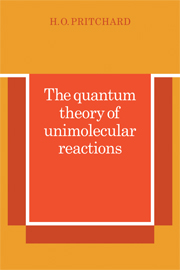Book contents
- Frontmatter
- Contents
- Preface
- Acknowledgements
- 1 The observed properties of thermal unimolecular reactions
- 2 The master equation for internal relaxation in molecules
- 3 Reaction as a perturbation of the internal relaxation
- 4 The specific rate function k(E) as an inverse Laplace transform
- 5 Unimolecular fall-off in strong collision systems
- 6 A molecular dynamic approach to specific rate functions
- 7 Building in the randomisation processes
- 8 Weak collision processes
- 9 How well does it all work?
- Appendix 1 Units, symbols, and errata
- Appendix 2 Rate constants for the thermal isomerisation of cyclopropane and for the thermal decomposition of cyclobutane
- Appendix 3 Computer programs for thermal unimolecular reactions
- Exercises
- References
- Author index
- Subject index
5 - Unimolecular fall-off in strong collision systems
Published online by Cambridge University Press: 04 August 2010
- Frontmatter
- Contents
- Preface
- Acknowledgements
- 1 The observed properties of thermal unimolecular reactions
- 2 The master equation for internal relaxation in molecules
- 3 Reaction as a perturbation of the internal relaxation
- 4 The specific rate function k(E) as an inverse Laplace transform
- 5 Unimolecular fall-off in strong collision systems
- 6 A molecular dynamic approach to specific rate functions
- 7 Building in the randomisation processes
- 8 Weak collision processes
- 9 How well does it all work?
- Appendix 1 Units, symbols, and errata
- Appendix 2 Rate constants for the thermal isomerisation of cyclopropane and for the thermal decomposition of cyclobutane
- Appendix 3 Computer programs for thermal unimolecular reactions
- Exercises
- References
- Author index
- Subject index
Summary
The concept of a strong collision has been bound intimately with the development of the theory of unimolecular reactions ever since its inception in the 1920s. In 1927, Rice & Ramsperger introduced the approximation that an activated molecule would be deactivated whenever it suffered a collision, although they were well aware of the limitations in making such an assumption [27.R]; they supposed that it would be possible at a later stage to determine the extent to which this approximation was untrue, but I doubt if it was envisaged that it would take more than 50 years for us to achieve a realistic understanding of the problem. The principal reason for this delay has been the failure of kineticists to formulate a proper definition of a strong collision; the usual description has been a rather intuitive one [72.R; 73.F], generally adequate within the framework of a steady state treatment of the reaction process, but not always consistent with the principle of detailed balancing. Two useful (and equivalent) verbal definitions of a strong collision taken from the literature are as follows: a strong collision is one in which so much energy is transferred that the subsequent condition of the molecule may be chosen at random (with appropriate weighting factors for energy) from all its possible states [66.B2]; strong collisions are Markovian events whose outcome follows the probabilities given by the Boltzmann distribution, without reference to the initial conditions [77.T1].
- Type
- Chapter
- Information
- The Quantum Theory of Unimolecular Reactions , pp. 41 - 64Publisher: Cambridge University PressPrint publication year: 1984

